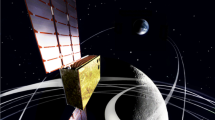Abstract
Nova-C is a lunar lander developed by the private company Intuitive Machines to deliver commercial payloads to the Moon. The IM-1 mission will launch and land the Nova-C near the Moon’s south pole. In this paper, Batch Dilution of Precision (DOP) methods are explored to assess Orbit Determination (OD) performance based on the nominal IM-1 trajectory. Utilizing a range to range-rate measurement error ratio to normalize the position uncertainties, this paper lays out the methodology to derive and incorporate a recursive, time-series Batch Least-Squares algorithm. Through the normalization, the Batch Least Squares algorithm produces a unitless Position Dilution of Precision metric. The normalized-weighted DOP method is used within a genetic algorithm optimizer to determine ground station tracking schedules that optimize OD performance. An assessment of OD performance is studied for key mission events including trajectory correction maneuvers, lunar orbit insertion, and descent orbit insertion. The long-term goal of this research is to develop a fully integrated DOP and Linear Covariance Analysis optimization tool to minimize operational costs and maximize OD performance.







Similar content being viewed by others
Data availability
Data sharing is not applicable to this article as no datasets were generated or analysed in this article.
References
Wood, L.J.: The evolution of deep space navigation: 1962-1989. In: 31st Annual AAS Guidance and Control Conference, AAS 08-051 (2008)
Cockrell, B.: RTCC requirements for mission G-Lunar module attitude determination using onboard observation. Project Apollo, Tech. rep. (1968)
Christensen, C., Reinbold, S.: Navigation of the Mariner 10 spacecraft to Venus and Mercury. In: Mechanics and Control of Flight Conference (1974), p. 844
Russell, R., Ellis, J.: Orbit determination for a Jupiter orbiter tour of the Galilean satellites. J. Spacecr. Rockets 12(6), 368–373 (1975)
Noort, B.v.: The gravity of Titan: Analysis of Cassini’s doppler tracking data and solar radiation pressure. Master thesis. Delft University of Technology (2021)
Battin, R.H.: An introduction to the mathematics and methods of astrodynamics. AIAA (1999)
Axelrad, P., Brown, R., Parkinson, B., Spilker, J.: GPS navigation algorithms. Global Positioning Syst.: Theory Appl. 1, 409–433 (1996)
Sands, O.S., Connolly, J.W., Welch, B.W., Carpenter, J.R., Ely, T.A., Berry, K.: Dilution of precision-based lunar navigation assessment for dynamic position fixing, In: Proceedings of the 2006 National Technical Meeting of The Institute of Navigation, (2006), pp. 260–268
Moon, Q., Geller, D. et al.: Validation of Linear Covariance Analysis for NOVA-C Cislunar Trajectory Design: https://www.researchgate.net/publication/370805481_Preprint_AAS_22-023_VALIDATION_OF_LINEAR_COVARIANCE_ANALYSIS_FOR_NOVA-C_CISLUNAR_TRAJECTORY_DESIGN/references (2022)
Carpenter, J.-R., D’Souza, C.N.: Navigation filter best practices, Tech. rep. (2018)
Moon, T., Stirling, W.: Mathematical methods and algorithms for signal processing. Prentice Hall, Hoboken (2000)
Holland, J.H.: Genetic algorithms. Sci. Am. 267(1), 66–73 (1992)
Wuerl, A., Crain, T., Braden, E.: Genetic algorithm and calculus of variations-based trajectory optimization technique. J. Spacecr. Rockets 40(6), 882–888 (2003)
The Math Works Inc. MATLAB version: 9.13.0 (R2022b) (2022)
Author information
Authors and Affiliations
Corresponding author
Additional information
Publisher's Note
Springer Nature remains neutral with regard to jurisdictional claims in published maps and institutional affiliations.
Rights and permissions
Springer Nature or its licensor (e.g. a society or other partner) holds exclusive rights to this article under a publishing agreement with the author(s) or other rightsholder(s); author self-archiving of the accepted manuscript version of this article is solely governed by the terms of such publishing agreement and applicable law.
About this article
Cite this article
Moon, Q., Geller, D.K. Batch Dilution of Precision Optimal Navigation Planning for Cislunar Environments. J Astronaut Sci 70, 44 (2023). https://doi.org/10.1007/s40295-023-00409-4
Accepted:
Published:
DOI: https://doi.org/10.1007/s40295-023-00409-4




